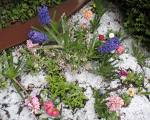So many times people have brought me a plant with one sickly-looking leaf and asked how they can revive it. It’s a bit like the Monty Python sketch: ‘My plant’s not dead it’s just resting’. Here is my advice that might just work for some plants that are just resting. Bury them.
It’s not a cruel as it sounds. For example, shrubby plants like heathers, hebes and lavenders, along with geraniums and busy lizzies, may actually form new shoots if you bury them. Just leave the last surviving leaves above ground. If it doesn’t work, at least they had a decent burial.
For plants that are just leggy or bare at the base, burying is an excellent rejuvenation technique.
Written By Alistair Ayres























